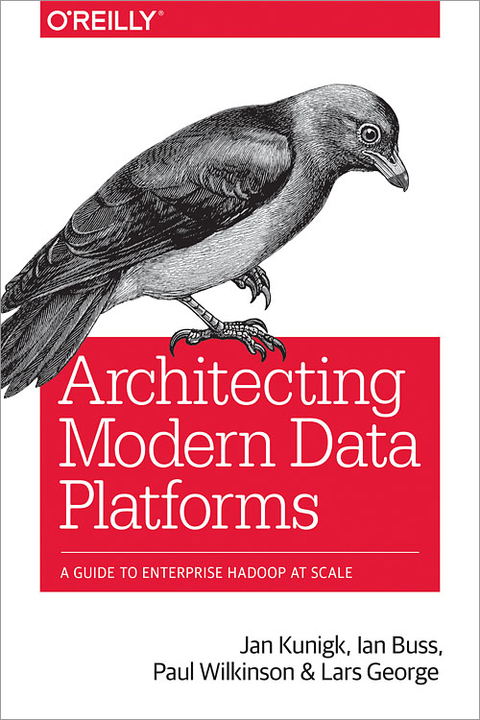
Architecting Modern Data Platforms
O'Reilly Media (Verlag)
978-1-4919-6927-4 (ISBN)
Ideal for enterprise architects, IT managers, application architects, and data engineers, this book shows you how to overcome the many challenges that emerge during Hadoop projects. You'll explore the vast landscape of tools available in the Hadoop and big data realm in a thorough technical primer before diving into:
Infrastructure: Look at all component layers in a modern data platform, from the server to the data center, to establish a solid foundation for data in your enterprise
Platform: Understand aspects of deployment, operation, security, high availability, and disaster recovery, along with everything you need to know to integrate your platform with the rest of your enterprise IT
Taking Hadoop to the cloud: Learn the important architectural aspects of running a big data platform in the cloud while maintaining enterprise security and high availability
Jan Kunigk has worked on enterprise Hadoop solutions since 2010. Before he joined Cloudera in 2014, Jan built optimized systems architectures for Hadoop at IBM and implemented a Hadoop-as-a-Service offering at T-Systems. In his current role as a Solutions Architect he makes Hadoop projects at Cloudera's enterprise customers successful, covering a wide spectrum of architectural decisions to the implementation of big data applications across all industry sectors on a day-to-day basis.
Lars George has been involved with Hadoop and HBase since 2007, and became a full HBase committer in 2009. He has spoken at many Hadoop User Group meetings, and conferences such as Hadoop World and Hadoop Summit, ApacheCon, FOSDEM, QCon etc. He also started the Munich OpenHUG meetings. Lars worked for Cloudera for over five years, as the EMEA Chief Architect, acting as a liaison between the Cloudera professional services team and customers as well as partners in and around Europe, building the next data driven solutions. In 2016 he started with his own Hadoop advisory firm, extending on what he has learned and seen in the field for more than 8 years. He is also the author or O'Reilly's "HBase The Definitive Guide."
Paul Wilkinson has been wrestling with big data in the public sector since before Hadoop existed and was very glad when it arrived in his life in 2009. He became a Cloudera consultant in 2012, advising customers on all things hadoop: application design, information architecture, cluster management and infrastructure planning the FullStack. After a torrent of professional services work across financial services, cybersecurity, adtech, gaming and government, he's seen it all warts and all. Or at least, he hopes he has.
Ian Buss began his journey into distributed computing with parallel computational electromagnetics whilst studying for a PhD in photonics at the University of Bristol. After simulating LEDs on supercomputers, he made the move from big compute in academia to big data in the public sector, first encountering Hadoop in 2012. After having fun building, deploying, managing and using Hadoop clusters, Ian joined Cloudera as a Solutions Architect in 2014. His day job now involves integrating Hadoop into enterprises and making stuff work in the real world.
Chapter 1 Clusters
Chapter 2 Compute and Storage
Chapter 3 Network
Chapter 4 Organizational Considerations
Chapter 5 Data Center Considerations
Chapter 6 Cluster Nodes Operating System
Chapter 7 Service Databases
Chapter 8 Hadoop Deployment
Chapter 9 Platform Validation Testing
Chapter 10 Integration
Chapter 11 Cluster Access
Chapter 12 High-Availability
Chapter 13 Backup & Disaster Recovery
Chapter 14 General Considerations
Chapter 15 How to build my security architecture in a Hadoop environment?
Chapter 16 How to build HA for my Hadoop Cloud environment
Chapter 17 How can I build an on-premise private cloud for Hadoop?
Chapter 18 How do I run Hadoop on public cloud infrastructure?
Chapter 19 Leveraging Cloud Storage
Chapter 20 How can I work with managed service providers?
Chapter 21 Automated Provisioning
| Erscheinungsdatum | 08.01.2019 |
|---|---|
| Verlagsort | Sebastopol |
| Sprache | englisch |
| Maße | 180 x 236 mm |
| Gewicht | 1140 g |
| Einbandart | kartoniert |
| Themenwelt | Mathematik / Informatik ► Informatik ► Datenbanken |
| Informatik ► Software Entwicklung ► Objektorientierung | |
| Informatik ► Software Entwicklung ► Software Architektur | |
| Mathematik / Informatik ► Informatik ► Theorie / Studium | |
| Wirtschaft ► Betriebswirtschaft / Management ► Wirtschaftsinformatik | |
| Schlagworte | Cloud • Cloud Computing • Hadoop • Softwareentwicklung |
| ISBN-10 | 1-4919-6927-X / 149196927X |
| ISBN-13 | 978-1-4919-6927-4 / 9781491969274 |
| Zustand | Neuware |
| Informationen gemäß Produktsicherheitsverordnung (GPSR) | |
| Haben Sie eine Frage zum Produkt? |
aus dem Bereich


